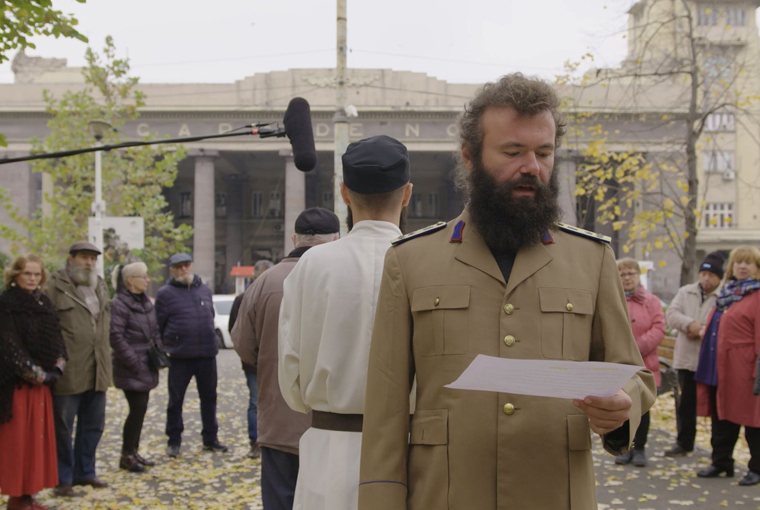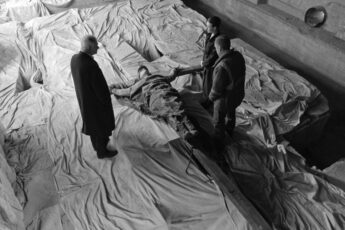Mythmaking and The Politics of Faith
Alexandru Solomon’s Arsenie: An Amazing Afterlife (Arsenie. Viața de Apoi, 2023)
Vol. 139 (November 2023) by Martin Kudláč
In Arsenie: An Amazing Afterlife, Romanian documaker Alexandru Solomon delves into the nature of belief, mythmaking, and the significant role of media in shaping collective consciousness. Building on his previous work, such as Tarzan’s Testicles (2017) — a film about a primate research institute set against the socio-political backdrop of a separatist region in the Caucasus — and his study of Romania’s transition to capitalism in Kapitalism: Our Improved Formula (2010), Solomon’s latest film examines the impact of religion on our worldview.
At the heart of the documentary is the enigmatic Father Arsenie, a priest revered as a healer both during his lifetime and after. His enduring legacy underscores the public’s desire for miraculous guidance, particularly in the challenging period following the collapse of Communism in Romania. The post-Communist transition, laden with uncertainty and a shift in societal norms, made many turn to figures like Father Arsenie, who represent hope, stability, and spiritual reassurance.
Father Arsenie Boca (1910-1989) remains an esteemed spiritual presence for many Romanians. Although he was never formally canonized, he’s often affectionately called “the Saint of Transylvania.” Recognized for his deep spiritual reflections, many believe he possessed a prophetic gift. His sermons, while anchored in Christian Orthodoxy, reportedly demonstrated a wide-ranging understanding of spirituality.
During Romania’s Communist era, the regime eyed him warily because of his expanding influence. Consequently, he faced persecution, was monitored closely, and endured multiple imprisonments. Following his passing in 1989, his resting place at the Prislop Monastery in the Hunedoara County has drawn thousands of Romanian pilgrims each year.
Solomon orchestrates a journey to the revered sites associated with Arsenie Boca and other locations central to his worship. Instead of straightforwardly delineating facts or recounting a sequential history, he prompts pilgrims to reenact moments from Boca’s life and peruse his correspondence, thereby fostering substantial interactions among the participants.
The director assembles a diverse group of individuals whose backgrounds and convictions reflect the multifaceted cultural and generational tapestry of Romania. On the one hand, there are the elder orthodox believers, imbued with memories and sensibilities from the Communist epoch. This stands in stark contrast to the younger new-age practitioners, who introduce a blend of time-honored faith and contemporary spiritual customs.
Fundamental to Solomon’s methodology is the fusion of found footage, reenacted sequences, group dialogues, and crucially, on-camera interviews. This mix of actual events with dramatized depictions blurs the lines between reality and fiction. The director fosters dialog with participants of Arsenie’s pilgrimage, helping them navigate historical records and revered tales so as to separate fact from lore. In doing so, Solomon addresses the duality present in historical accounts — the frequently ambiguous interplay between objective fact and interpretive myth. Moreover, this social experiment illustrates how belief is influenced by one’s background, identity, and desire to believe.
The desire to believe, the irrational urge to create meaning when facing a significant void, anticipates our current era of hoaxes, conspiracies, and fake news. Dissecting Father Arsenie’s legend showcases the effort required to challenge questionable narratives. It underscores the depth of research, double-checking, and verification that are needed to counter even a small piece of false or misinterpreted information. Yet, one still remains at the mercy of others’ willingness to accept facts over deeply held illusions.
One method Solomon utilizes is introducing the pilgrims through Securitate files — documents from the Romanian secret police. This deliberate juxtaposition of official state narratives with intimate faith stories prompts another confrontation. Participants grapple with institutional history alongside individual memories and beliefs about Arsenie Boca. Both facets bear layers of context that are not just historical or personal, but also political.
At first glance, Solomon delicately unveils the mechanisms behind organized religion: how faith is performative, and how it’s enacted and exhibited both in the private and public realms. These reenactments serve as reflective mirrors. However, Arsenie: An Amazing Afterlife is more than just a deconstruction of a religious myth or a cult of personality rooted in a religious environment. Through this performative documentary, Solomon examines the underpinnings of belief and myth-making that go beyond the religious sphere.
Solomon, coming from a background in political filmmaking, broadens the documentary’s scope beyond its titular figure. Arsenie serves as a catalyst to explore deeper societal undercurrents. Solomon’s insights touch upon the institutional apparatus shaping public narratives. Father Arsenie’s legacy is not merely an organic tale; it’s a construct influenced by various entities, including the church, the media, and the Securitate, to name but a few.
The film provides a glimpse into aspects of the collective delusion that echo the zeitgeist, reminiscent of fabricated mythologies like QAnon. While Solomon’s primary focus is the intriguing posthumous renown of the uncanonized priest and mystic, and the commercialization and institutional utilization of his image, it’s challenging to overlook the broader implications of how influence is constructed, especially within conservative communities.
While Solomon is recognized for his politically-charged documentaries, in Arsenie that theme surfaces prominently near the end, where he introduces footage addressing the controversial alliance of the Orthodox Church with Putin. Though Solomon subtly dances around the topic during the pilgrimage journey, it’s confronted directly in the film’s culmination. Arsenie: An Amazing Afterlife delves into individual memory, the quest for meaning in mythicized personalities, institutional motives, and the flexibility and vulnerability of public perception. Beginning with a playful nod to a saint’s image peddled in markets, the film concludes with a poignant note on the instrumentalization of faith for political reasons.
In Arsenie: An Amazing Afterlife, Alexandru Solomon once again showcases his ability to blend the personal with the political, capturing the intricacies of human belief against the backdrop of societal shifts. Drawing from his earlier works, Solomon continues to interrogate the subtle interplay between memory, faith, and power structures. The journey through Father Arsenie’s legacy serves both as a microcosm of Romanian identity and as a reflection on global phenomena of belief, mythmaking, and influence. Solomon’s storytelling and direction emphasize that while myths may be timeless, their interpretation and utilization are invariably shaped by the context they appear in. As with his previous endeavors, Solomon prompts viewers to question, reflect, and most importantly, engage with the narratives that shape our collective consciousness.




Leave a Comment